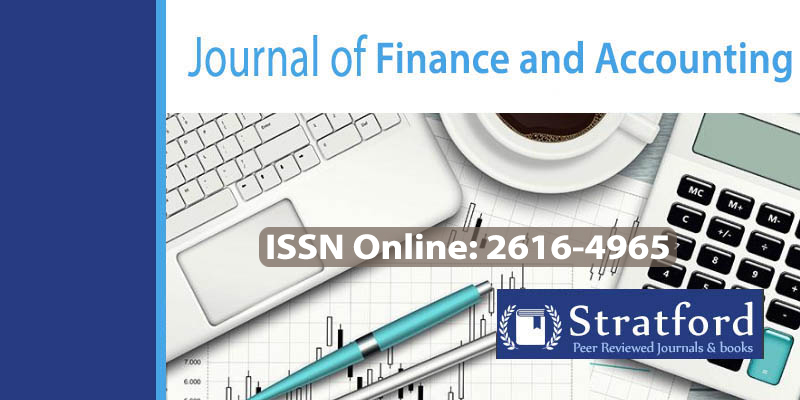Multiple Taxation and Financial Performance of Manufacturing Firms Listed at The Nairobi Securities Exchange, Kenya
DOI:
https://doi.org/10.53819/81018102t30156Abstract
The performance of the manufacturing sector is affected by several factors, key among them being the high costs of doing business. Excessive taxation in the form of high tax rates, double, and multiple taxes are some of the challenges facing manufacturing industries. The main aim of this research was to analyze the influence of multiple taxes on the financial performance of manufacturing firms listed on the NSE. The following objectives were used to guide the study: to determine the influence of corporate tax on performance, to study the effect of excise duty on performance, to establish the effect of customs duty on performance, and to determine the moderating effect of firm size on the relationship between multiple taxes and financial performance of manufacturing firms listed on the NSE. This research adopted the agency theory, ability-to-pay theory, optimal taxation theory, and profit maximization theory. An explanatory research design was used, and the research philosophy was positivism. The study population was the 9 manufacturing firms listed on the NSE as of December 2021. Secondary data from listed manufacturing firms' annual financial reports from 2012 to 2021 was used in the study. Data was analyzed using Stata 20. Descriptive statistics like frequencies and percentages and inferential statistics like correlation and regression were generated. The dependent-independent relationship was shown using correlation coefficients. For hypothesis testing, panel regression was used. The results were presented in tables and figures with relevant interpretation and discussion. Every ethical consideration was followed. Corporate tax had no significant positive effect on financial performance (p=0.947 > 0.05). Results indicate a significant negative impact of excise duty on financial performance (p=0.000 < 0.05). The study found that customs duty significantly influenced financial performance (p=0.022 < 0.05). Firm size significantly affected the relationship between multiple taxes and financial performance, and its interaction with corporate taxes, customs duty, and excise duty affected ROE. It is recommended that managers of listed firms put proper procedures in place to enhance and increase their financial performance through corporate tax planning.
Keywords: Multiple Taxation, Financial, Performance, Manufacturing Firms, Nairobi Securities Exchange
References
Adefeso, A & Tawose, T. (2015). Tax policy reforms and economic performance in Nigeria. The IUP Journal of Applied Finance, 21(2), 49-63.
Al-Hawar, M. (2019). The effect of automated service quality on bank financial performance and the mediating role of customer retention. Journal of Financial Services Marketing, 2(1), 13–19
Awiti, C.A (2016). Taxes and economic performance in Kenya: A Theoretical Approach. Nairobi, Kenya.
Baba, S., & Nasieku, T. (2016). Effect of macroeconomic factors on financial performance of commercial banks in Nigeria. International Journal of Social Science and Information Technology, 2(IX).
Brown, R.M. (1928). Tax policy in emerging countries. Environment and Planning C: Government and Policy. 26(2), 73-36.
Ezugwu, C. I. & Akubo. D. (2019). Analysis of The Effect of High Corporate Tax Rate On The Profitability of Corporates Organizations In Nigeria -A Study Of Some Selected Corporate Organizations.
Jensen, M. C., & Meckling, W. H. (1976). Theory of the firm: Managerial behavior, agency costs and ownership structure. Journal of Financial Economics, 3(4), 305-360. https://doi.org/10.1016/0304-405X(76)90026-X
Kaplow, L. (2020). The theory of taxation and public economics. Princeton University Press.
Karingi S.N. & Wanjala, B. (2016). The Tax Reform Experience of Kenya, Research Paper No. 2015/67 Addis Ababa United Nations Economic Commission for Africa (UNECA), 2 Kenya Institute for Public Policy and Research and Analysis (KIPPRA), Nairobi
Kaushik, A. K., & Rahman, Z. (2015). Innovation adoption across self-service banking technologies in India. International Journal of Bank Marketing. https://doi.org/10.1108/IJBM-01-2014-0006
Koetter, M. (2004). The stability of bank efficiency rankings when risk preferences and objectives are different. European Journal of Finance, 14(2), 115-135. https://doi.org/10.1080/13518470701380068
Lambert, R (2018). The history of the investment Tax credit. Columbus state, USA
Pfister, M. (2019). Taxation for investment and development: an overview of policy challenges in Africa (Rep.). Ministerial meeting and Expert Roundtable of the NEPAD-OECD Africa investment Initiative.
Pigou, A (1928). The Economics of Welfare. London, England: Macmillan and Co.
Ronge, E., Njeru, B., & Ojwang, D. (2015). Implicit taxation of the Agricultural Sector in Kenya (Working paper No. 52). Nairobi: The Kenya Institute for Public Policy Research and Analysis.
Shehzad, C. T., De Haan, J., & Scholtens, B. (2018). The relationship between size, growth and profitability of commercial banks. Applied economics, 45(13), 1751-1765. https://doi.org/10.1080/00036846.2011.637896
Smith, A. (1776). An Inquiry into the Nature and Causes of the Wealth of Nations. Oxford University Press. https://doi.org/10.1093/oseo/instance.00043218
Tomal, D.R., & Jones, K.J. (2015). A comparison of core competencies of women and men leaders in the manufacturing industry, The Coastal Business Journal, 14, 1, 13-25



